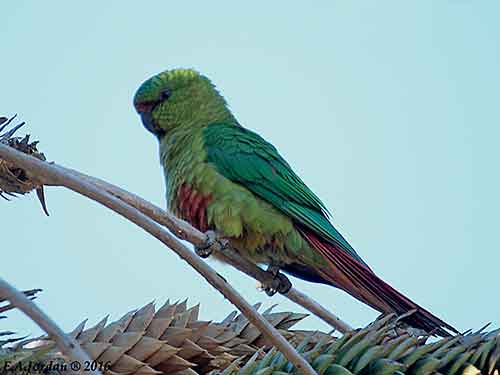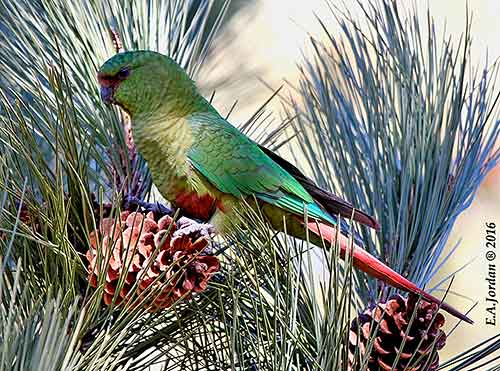
Fr: Conure magellanique
Ang: Austral Parakeet
All: Smaragdsittich
Esp: Cotorra Austral o Cachaña
Ita: Parrocchetto australe
Nd: Magelhaenparkiet
Sd: magellanparakit
Photographers:
John Anderson
John Anderson Photo Galleries
Jean-Claude Billonneau
Photographe-témoin de la Beauté du Monde
Eduardo Andrés Jordan
MIS AVES – AVES DE ARGENTINA
Text by Nicole Bouglouan
Sources:
HANDBOOK OF THE BIRDS OF THE WORLD vol 4 by Josep del Hoyo-Andrew Elliott-Jordi Sargatal - Lynx Edicions - ISBN: 8487334229
PARROTS OF THE WORLD – An Identification Guide – by Joseph M. Forshaw – Princeton University Press – ISBN 0691092516
Consumption of Larvae by the Austral Parakeet (Enicognathus ferrugineus)
Red de Observadores de Aves y Vida Silvestre de Chile
Exotic mammals threaten Araucaria Forests by displacing Austral Parakeets
Wikipedia, the free encyclopaedia
Wikipedia, la enciclopedia libre
Austral Parakeet
Enicognathus ferrugineus
Psittaciformes Order – Psittacidae Family
INTRODUCTION:
The Austral Parakeet is the more southerly distributed of Psittaciformes. It is found in S Chile to extreme S of both Chile and Argentina to Tierra del Fuego. Two subspecies share the large range.
It frequents both Nothofagus and Araucaria forests, and feeds on leaf buds and seeds, fruits, berries and bulbous roots.
The Austral Parakeet nests in cavities, usually holes in trees. It may occasionally build a twig nest in bamboo. The species is solitary nester. However, outside breeding season, they usually live in flocks.
The species often occurs at lower elevation than the Slender-billed Parakeet. Both species are very similar, but the Austral Parakeet has shorter and broader upper mandible, slightly smaller body size and some differences in plumage.
The Austral Parakeet is affected by deforestation and pet trade. The species is relatively common and benefits from protected areas in both Chile and Argentina. It is not globally threatened at the moment.
DESCRIPTION OF THE BIRD:
Biometrics:
Length: 28-36 cm
Weight: 155-160 g
The Austral Parakeet is very similar to the Slender-billed Parakeet and their territories overlap in Central Chile.
The plumage is dull green with dusky scaled pattern made by the dark edges of the feathers. Crown and upperwing are darker green, mostly emerald green with greyish-brown inner webs to flight-feathers. The long graduated tail is dull reddish.
The underparts are yellower with dull brownish-red patch on central belly.

On the green head, forehead and lores are dull reddish, but this area is more reduced than in the Slender-billed Parakeet. The crown is emerald green with some dark bars.
The bill is dark grey. The eyes are reddish-brown with grey eyering. Legs and feet are grey and zygodactyl (with two toes forwards and two backwards).
Male and female are similar.
The juvenile has duller reddish markings on forehead and belly.
SUBSPECIES AND RANGE:
The Austral Parakeet has two subspecies.
E.f. ferrugineus (described above) is found in southernmost Chile (in Aisén and Magallanes) and southern Argentina, from SW Chubut S to Tierra del Fuego.
E.f. minor is found in S Chile, from O’Higgins S to Aisén, and on the eastern slope of the Andes in SW Argentina, from Neuquén, S to W Chubut.
This race is darker green. The less extensive brownish-red patch on belly is darker, but sometimes absent. This race is slightly smaller than nominate.
HABITAT:
The Austral Parakeet is mainly found in wooded habitats including Nothofagus, Araucaria and Quercus forests. It also frequents open woodland, shrubland and farmland with scattered wooded plots.
In extreme South, it stays near the sea level, whereas in the northernmost part of the range, it can be found up to 2,000 metres of elevation.
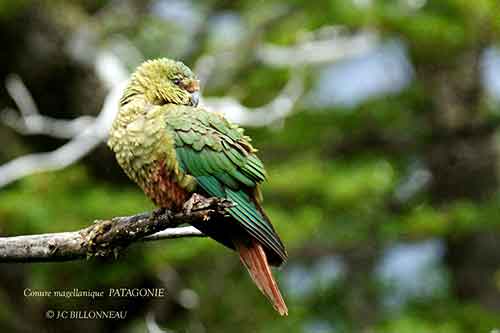
CALLS AND SONGS: SOUNDS BY XENO-CANTO
The Austral Parakeet in flight gives shrill calls described as “grie…grie” and more strident “grieee-grieee-grieee” when alarmed.
But we can hear harsher, grating notes, and also more melodious chirruping calls. The sounds are weaker than those given by the Slender-billed Parakeet.
BEHAVIOUR IN THE WILD:
The Austral Parakeet feeds on seeds of grasses, buds, fruits, berries and bulbous roots. But it favours the seeds of Araucaria araucana and leaf buds of Nothofagus and poplars.
It feeds on seeds of Araucaria directly taken from the trees before the seeds disperse naturally, and later, it feeds on fallen seeds after moving them to other perches while dispersing the seeds.
It also consumes pollen and sap of Araucaria, but also seeds, flowers, pollen and buds of other native plant species.
An observation in the northern part of the range reports that the birds also feed on larvae in the austral, temperate forests of Argentine Patagonia, especially during the pre-and-post reproductive seasons.
The species is known to feed on larvae from Homoptera, Lepidoptera, Diptera and Coleoptera. This observation suggests that the Austral Parakeet could be more insectivorous than previously thought, especially before and after the reproduction.
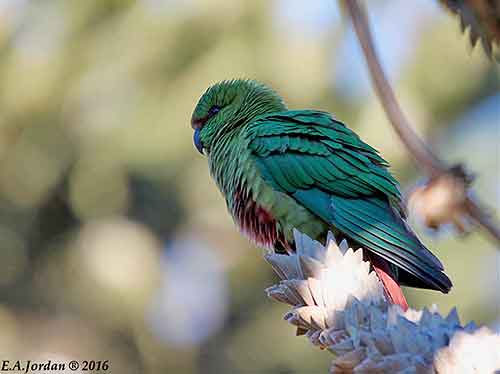
The Austral Parakeet comes to the ground to take grass seeds, but when feeding in trees, the birds alight on the highest branches and climb down into the canopy to feed. They are largely arboreal.
They can be seen in flocks of 10-20 individuals, but sometimes up to 100 or more. A sentinel warns the group if a predator is approaching. They usually forage and feed silently, but when disturbed or alarmed, they take off and fly fast between the trees while calling loudly.
The Austral Parakeet breeds in December. It nests in tree holes, but it may occasionally build its own nest in bamboo Chusquea, depending on cavity availability.
They are monogamous with long-term pair bonds.
The Austral Parakeet is resident in the southern part of the range, despite severe winters.
In the northern part, they move down from Argentina to Chile. This period varies according to weather conditions and food availability.
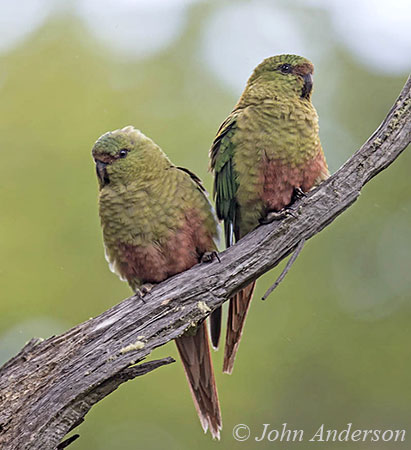
The Austral Parakeet has swift, direct flight. It often flies only a few metres above the ground, rising over or around low bushes. It is very agile in flight.
When a group is disturbed or alarmed, the birds take off together as soon as the sentinel gives alarm calls.
REPRODUCTION OF THIS SPECIES:
The Austral Parakeet breeds from December to March. It usually nests in tree cavity, often large, dead oak. The hole is lined with pieces of vegetation and feathers.
They are monogamous with long-term pair bonds. They can be seen flying side-by-side throughout their habitat. They remain together all year round.
The female lays 4-8 white eggs. She incubates alone during about 26 days (in captivity). The male remains in the surrounding of the nest and feeds the incubating female which rarely leaves the nest.
The first fledglings are seen in March-April. Both parents feed the young.
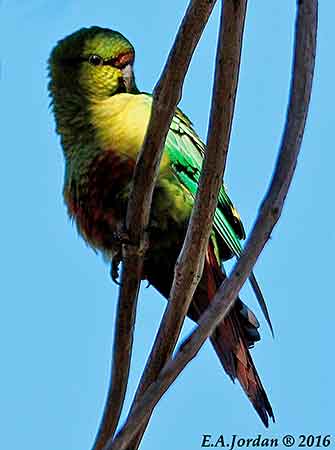
PROTECTION / THREATS / STATUS:
The Austral Parakeet is threatened by deforestation involving decline of the population. Competition for cavities with non-native species and pet trade are also significant threats, although this species is uncommon in captivity.
Fortunately, the Austral Parakeet occurs in protected areas and parks in both Chili and Argentina.
The size of the population is unknown, but the species is described as common throughout the range. It is not globally threatened.
The Austral Parakeet is currently evaluated as Least Concern.
